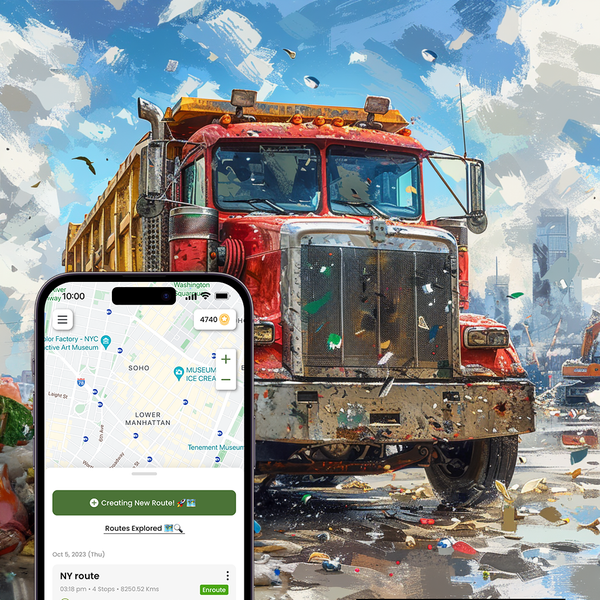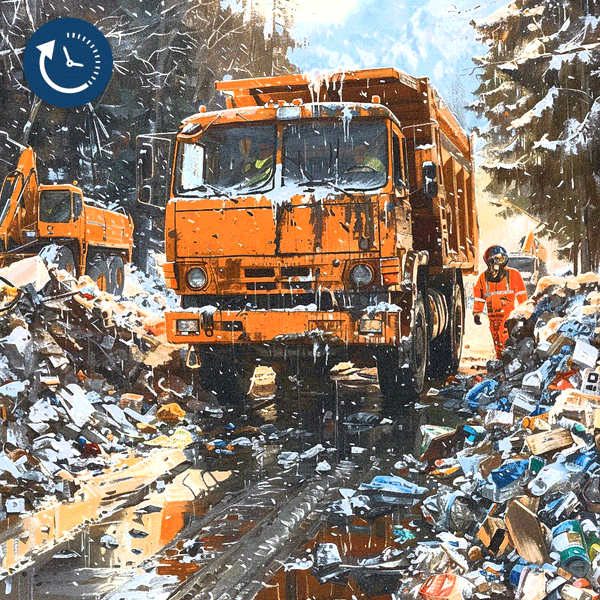Hey there fellow waste warriors! Veena here with DynoRoute to unload some major trash valet routing mistakes I see companies make. If you're new to this, you might want to check out our Complete Guide to Planning Optimized Routes for Trash Valet Services.
Look, I get it. Route planning feels like a giant logistical nightmare. You juggle endless challenges trying to balance productivity, costs, service, and sustainable growth. It’s no wonder suboptimal practices creep in! But did you know there are 5 Must-Have Features of Route Optimization Software for Trash Valet Services that can help?
But avoiding these common pitfalls can lead to serious efficiency gains, cost savings, and happier customers.
Let’s closely examine the 6 biggest trash pickup routing mistakes eating into operations - and how route optimization best practices offer a superior path:
Why Optimization Matters
Before diving in, let's briefly touch on why you can't afford to ignore the importance of optimization:
- Reduces fleet mileage 20-30% slashing fuel, maintenance, labor costs
- Increases stops per driver/hour 20% boosting productivity
- Enables consistently reliable on-time arrival critical for retention
- Provides data visibility to continually improve and grow
Leading valet companies leverage technology to drive this competitive advantage. Can you afford not to?
Now, onto common mistakes that prevent achieving optimization's full benefits...
Mistake 1: Failing to Account for Operational Constraints
It’s tempting to disregard real-world limitations when mapping routes:
Exceeding Vehicle Capacity
Overloading trucks forces inefficient mid-route emptying when max weight or volume is hit:
“We sent overloaded trucks out at first. They'd often have to dump mid-route costing hours of time and excess mileage.” - Todd M., WasteCare Valet
| Metric | Impact |
|---|---|
| Avg extra miles per dumped load | 20 miles |
| Est. annual dumped loads per truck | 26 loads |
| Total excess annual miles per truck | 520 miles |
Excess dumping mileage diminishes productivity and boosts costs.
Overworking Driver Maximum Hours
Excessive 12+ hour routes burn out drivers. Studies show productivity steeply declines after 10 hours of driving:
“We saw high turnover initially because our manual routes had unrealistic timeframes leading to driver fatigue and retention issues.” - Amanda K., ABC Valet
| Metric | Impact |
|---|---|
| Est. OT hours from overscheduling | 8 hrs/driver/week |
| Est. annual OT expense per driver | $12,500 |
| Increased annual driver turnover | 37% |
Heavy overtime leads to frustration, unsafe conditions, and churn.
Inflexible Customer Commitments
Not building in buffers means missed SLAs from variability like traffic, added stops etc:
“By ignoring real-world variability in manual plans, we constantly missed service window commitments and lost business.” - Ryan F., Tiger Waste
| Metric | Impact |
|---|---|
| Average minutes late per stop | 8 min |
| Annual missed service windows | 45 windows |
| Est. lost annual revenue | $31,000 |
Lack of slack destroys customer confidence and retention.
The Solution
Sophisticated route optimization platforms allow configuring precise operational constraints so routes adhere to real-world logistical realities:
“After we implemented DynoRoute with our actual limitations configured, our routing achieved way higher efficiency.” - Todd M.
Proper constraint planning prevents headaches, delays, and bloated costs.
Mistake 2: Failure to Cluster Nearby Stops
Forgetting to sequence stops based on proximity leads to excessive crisscrossing mileage:
“We had no process for coordinating stops in the same neighborhoods. Trucks were zig-zagging wildly across our territory burning gas.” - Ryan S., ABC Valet
| Metric | Unoptimized | Optimized |
|---|---|---|
| Annual miles per truck | 227,300 | 164,250 |
| Est. fuel cost per mile | $1.25 | $1.25 |
| Est. annual fuel cost | $312,000 | $210,000 |
Intelligent algorithms minimize deadhead travel by tightly clustering nearby stops. This streamlines routing and cuts costs quickly.
“After optimizing, our routing density increased by 30% almost immediately just from coordinating stops in closer proximity.”
Location-based clustering squeezes significant efficiency from existing routes.
Mistake 3: Imbalanced Route Workloads
Manual routing often distributes work unevenly. Some routes become overloaded while others are very light:
“We initially just split customers evenly across trucks alphabetically. Some drivers had 20+ hour routes while others had only 4 hours.” - Amanda K., ABC Valet
| Metric | Impact |
|---|---|
| Avg OT hours per driver per week | 8 hrs |
| Est. annual OT expense | $520,000 |
| Est. increased annual driver turnover | 32% |
Uneven distribution leads to bloated labor costs and retention issues.
Sophisticated software considers truck volumes, route density, optimal clusters, and driver capabilities to distribute stops with workloads perfectly balanced:
“Balancing our labor hours across routes helped reduce excessive overtime costs and driver fatigue issues.”
Balancing route workloads optimizes labor utilization and prevents burnout.
Mistake 4: Static Routes That Can't Adapt
Printed route sheets lack flexibility to change when unexpected issues arise. But with modern tools, you can easily adapt. Wondering about the difference? Here's our take on Manual vs. Software Trash Valet Routing: What's Better?
“With paper maps, we had no way to quickly modify things when priority pickups came in or a truck broke down. It was total gridlock.” - Ryan F., Tiger Waste
| Situation | Impact |
|---|---|
| Added VIP pickup | Missed SLA |
| Truck breakdown | 4+ hour delay |
| Major traffic delay | 7+ missed pickups |
Modern optimization enables fluidly adapting routes in minutes:
Add a VIP Stop: Easily insert urgent requests at the optimal point along each route.
“We can now grab hot requests as they come in and sequence them into existing routes seamlessly.”
Cover a Breakdown: Instantly reassign affected stops across other vehicles.
“Vehicle issues no longer derail us - we reroute things and everybody stays moving.”
Account for Traffic: Navigate around delays and congestion in real-time.
“Live navigation integration helps us skirt traffic automatically without missed SLAs.”
Agile routing means responding to changes without disruption.
Mistake 5: Fragmented Route Communication
Printed driving directions alone cause headaches:
“After morning dispatch, drivers were in the dark. For route changes, we had no way to notify crews in the field.” - Ryan S., ABC Valet
Limited communication breeds confusion and impacts execution:
| Issue | Impact |
|---|---|
| Last minute route alterations | Missed SLAs |
| Truck breakdowns | 4+ hours lost |
| New urgent customer requests | Angry callers |
Proper communication keeps drivers informed and nimble:
Mobile Optimization Visibility: Drivers access live routes, real-time navigation, and changes on tablets or phones.
“Giving drivers mobile visibility into routes has been a total game changer for our fleet.”
In-App Updates: New assignments or alterations get pushed in real-time.
“The instant in-app notifications keep our team in sync when plans change.”
In-Field Verification: Confirm pickups, log issues, and communicate with dispatch on the fly.
“We closed the loop allowing drivers to verify tasks and update us from the road.”
Enhanced communication minimizes missed SLAs and keeps field crews aligned.
Mistake 6: Minimal Data and Route Analytics
Hard to improve what you can’t measure. Manual routing means limited operational insights.
“We were flying blind without access to detailed data like overtime hours, stops per truck, driver-specific KPIs, etc.”
Sophisticated platforms deliver robust analytics on:
- Stops/hours per driver
- Planned vs actual route times
- Truck utilization and fill rates
- Driver-specific performance
- Overtime wages
- Service area density heatmaps
- Revenue per stop
“The treasure trove of data we get from DynoRoute has allowed us to refine our operations continuously over time.”
With this visibility, you gain actionable insights to drive ongoing improvements.
Key Takeaways
The data shows optimizing routes is clearly critical for valets. But what if you're just getting started? Here are some tips... And if you're curious about the impact, here are Top 10 Stats Showing the Impact of Route Optimization for Trash Valet Companies.
- Document your current operations - metrics, pain points, constraints
- Research optimization software options - demos, peer referrals
- Build internal alignment on goals
- Start with pilot testing - pick constrained region or vehicle fleet
- Expand gradually based on learnings
- Leverage provider expertise in tailoring optimization approach
Now you can avoid common mistakes, work smarter, and turn routing into a competitive advantage!
Ready to Optimize?
Don’t settle for profits lost to inefficient routing. With route optimization best practices and technology, you can compete and grow more profitably.
Experience the benefits yourself! Start a free trial of DynoRoute’s award-winning platform. Or request a custom demo and proposal tailored for your unique operation.
Until next time my friends. This is Veena signing off!








